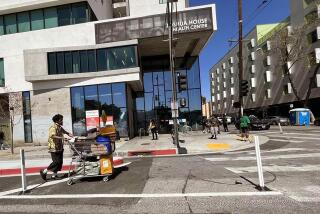Lincoln Savings Is Placed Into Receivership : Regulators Claim S&L; Used ‘Gimmickry’ to Manufacture Income
- Share via
Federal regulators, releasing an audit claiming that more than half the income Lincoln Savings & Loan recorded since 1984 was manufactured through “accounting gimmickry,” put the troubled Irvine-based S&L; into receivership Thursday.
The action cuts off shareholder rights and lays the groundwork for possible liquidation or sale of the S&L;, which federal regulators said had a net loss of $847 million for the first six months of 1989 and a negative net worth--more liabilities than assets--of $631.4 million.
The Federal Home Loan Bank Board had ordered the audit after seizing the institution on April 14, a day after Lincoln’s parent firm, American Continental Corp. of Phoenix, filed for bankruptcy protection. The parent company also put 11 Lincoln subsidiaries, which hold most of Lincoln’s $4.08 billion in assets, into bankruptcy in April.
The receivership effectively severs American Continental’s ownership of Lincoln and provides regulators a weapon with which to bar the company from challenging their operation of the subsidiaries.
Assets Transferred
The cost of returning financial health to Lincoln, a large investor in Arizona’s now-depressed real estate market, has been estimated by industry consultants at up to $2.5 billion, which would be the costliest thrift collapse ever.
In Thursday’s action, regulators transferred Lincoln’s assets into a newly created institution, known as Lincoln Savings & Loan, Federal Assn. The new federal association will continue to be operated by the Federal Deposit Insurance Corp., which has been operating Lincoln in conservatorship since the takeover.
Depositors won’t be affected by the action, and the new S&L; will continue to conduct business as usual, M. Danny Wall, the bank board’s chairman, said in a prepared statement.
Lincoln was not declared insolvent at the time it was seized, but regulators suspected that questionable accounting techniques used by American Continental masked its true condition.
“Some of us knew that Lincoln has been insolvent for a long time,” said Lawrence White, a bank board member. “But we needed a clear statement from auditors that it was insolvent before we could put it in receivership.”
That confirmation came July 14 in a report from Kenneth Leventhal & Co., a public accounting firm that conducted the limited audit. Regulators released the report Thursday.
“Seldom in our experience as accountants have we encountered a more egregious example of the misapplication of generally accepted accounting principles,” the report states.
Lincoln was turned into “an engine designed to funnel insured deposits to its parent” in the form of tax credits and dividends, the firm said. To allocate taxes to the parent, though, Lincoln had to show profits and “turned to accounting gimmickry,” Leventhal said.
‘Created Profits’
The S&L; “generated earnings by making loans or other transfers of cash or property to facilitate sham sales of land,” the report concludes. “It created profits by making loans. Many of the loans were bad. Lincoln was manufacturing profits by giving its money away.”
James J. Feder, a bankruptcy lawyer for American Continental, said the firm had not received a copy of the Leventhal report and could not comment specifically.
But he said regulators had been examining Lincoln since 1986 and “none of this had been raised before.” He charged that regulators are forcing Lincoln to write down assets on matters the regulators had previously approved.
In a prepared statement, American Continental criticized the government’s action to put Lincoln in receivership. The company claimed the S&L;’s deteriorating condition was caused by the government’s “own deliberate or reckless mismanagement or by a baseless writedown of asset value.”
Besides releasing the Leventhal report, the bank board also released financial figures on Lincoln for the first six months. The figures differ from those released last week by the state Department of Savings and Loan.
Lincoln lost $788 million in the second quarter and $847 million in the first six months. Its liabilities at the end of June exceeded its assets by $631.4 million, according to accounting methods used by regulators. Using stricter general accounting principles, the state said Lincoln has a $906-million deficit.
The receivership action also may thwart American Continental’s recent effort to reorganize its debts in a new firm that would include one of the 11 bankrupt Lincoln subsidiaries. That subsidiary, Amcor Funding Corp., owns the General Oriental stock as well as American Founders Life Insurance Co.
The receivership also may cut off any hope that American Continental’s 22,000 debtholders had of retrieving $200 million they had invested in high-yield--so-called junk--debt securities that many of them had thought were insured.
A successful reorganization would have given them their money back, though over a longer period of time, said Donald Makami, a Fountain Valley dentist and bondholder who is one of the bondholder leader.
Steve Webb, a free-lance writer in Phoenix, contributed to this story.
More to Read
Inside the business of entertainment
The Wide Shot brings you news, analysis and insights on everything from streaming wars to production — and what it all means for the future.
You may occasionally receive promotional content from the Los Angeles Times.










